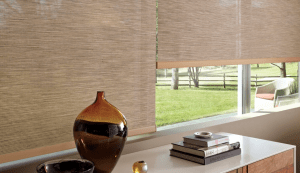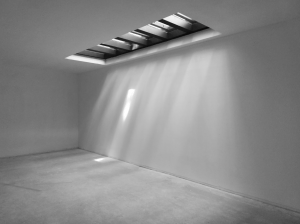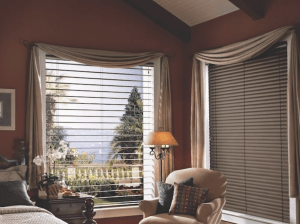Measuring your windows for blinds is an essential step to ensure a perfect fit. This guide will take you through the step-by-step process, whether you’re installing inside mount or outside mount blinds. Follow these instructions carefully for a professional result.
Tools You’ll Need
- Steel measuring tape
- Pencil and notepad
- Level (optional)
Before you begin the actual measurements, it’s crucial to gather all the tools you’ll need to achieve accurate results. A steel measuring tape is essential for precision, far superior to cloth tapes used for tailoring. A pencil and notepad are indispensable for recording the measurements instantly, avoiding any confusion later. While optional, a level can be used to ensure that your measurements account for any potential discrepancies in the levelness of your window frames or floors.
Inside Mount vs Outside Mount
Before measuring, decide whether you want an inside or outside mount for your blinds. Each option offers different aesthetic and functional benefits that can enhance your window treatments.
Inside Mount
Inside mount blinds fit inside the window frame, offering a sleek, minimalist look. This type is ideal for showcasing decorative window trim or maximizing natural light. When opting for inside mount blinds, you should ensure that the window recess is deep enough to accommodate the mount. This placement allows for optimal light control while maintaining the desired aesthetics of the space.
Outside Mount
Outside mount blinds are installed outside the window frame, covering the entire window. These are a great option for blocking more light or if your windows lack sufficient depth for an inside mount. If you’re looking to achieve an impression of larger windows, outside mount blinds can make the window frame appear more substantial and grander. This type of mount is also ideal for windows with shallow window openings that cannot accommodate inside mount blinds.
How to Measure for Inside Mount Blinds
Step 1: Measure the Width
To measure the width of your window for inside mount blinds, it’s crucial to measure across the window opening in three places: the top, middle, and bottom. Use the narrowest of these three measurements for your blinds to ensure they will fit inside the window frame without being obstructed. Record your measurements to the nearest 1/8 inch. This precision ensures that your blinds and shades can move up and down smoothly without brushing against the window frame.
Step 2: Measure the Height
Next, measure the height of the window from the top inside edge down to the sill in three places: the left side, middle, and right side. Use the longest of these measurements when ordering your blinds, rounding up to the nearest 1/8 inch to ensure the blinds cover the entire window opening. This step is crucial for vertical blinds, which require precise height measurements for optimal function and appearance.
Step 3: Check the Window Depth
Ensure that your window has enough depth to accommodate an inside mount. The required depth will depend on the type of blinds you are installing. Refer to the manufacturer’s guidelines for specific depth requirements to ensure the blinds sit flush with the window frame and operate correctly without hitting the window’s handles or locks. For blinds that need to sit deeper, consider using extension brackets to provide additional clearance.
This section of the guide helps you with the first phase of installing inside mount blinds, ensuring that your window frame is suitably prepared to receive your new window treatment, achieving both functional utility and visual appeal. In the following sections, we’ll explore how to measure for outside mount blinds and address common mistakes to ensure you measure blinds accurately for your window treatments.
How to Measure for Outside Mount Blinds
Step 1: Measure the Width
For outside mount blinds, you measure the width of the area you want to cover, not just the window itself. To ensure optimal coverage and minimize light leakage, it’s important to extend the measurement beyond the width of the window opening. Add at least 1.5-2 inches on each side of the window frame. This addition helps to cover any potential gaps that could allow light to seep through, providing enhanced privacy and better light control. For window treatments like solar or roller shades, consider adding 2-3 inches on each side to ensure that the fabric completely covers the window width, thus maximizing privacy and light management.
Step 2: Measure the Height
Start your height measurement from the point where you intend to install the headrail, which should be above the window frame. Extend the tape measure to the desired endpoint, which could be just below the windowsill or lower if you prefer extended coverage. By allowing your blinds to extend past the sill, you can achieve a more tailored appearance that enhances room aesthetics while providing additional privacy and light blockage. Make sure to measure in three places – left, middle, and right – to account for any irregularities in wall or window construction, using the greatest of these measurements to ensure complete window coverage.
Step 3: Account for Obstacles
Before finalizing your measurements for outside mount blinds, it’s crucial to consider any potential obstacles that could impact the blinds’ functionality. Check for any protruding window hardware, door handles, moldings, or trim that might interfere with the operation of your blinds. If such obstructions are present, using spacer blocks or extension brackets can be an effective solution. These additions help to position the blinds further away from the wall or window frame, allowing smooth operation without any hindrance. Properly accounting for these elements ensures that your blinds hang correctly and remain fully operational.
Double-checking your measurements after considering these factors is essential to prevent any errors that could affect the installation and functionality of your blinds. In the next sections, we will review the importance of verifying your measurements and discuss common mistakes to avoid when measuring for window treatments. This careful attention to detail will help you achieve professional-quality results with your new blinds and shades.
Double-Check Your Measurements
Before placing your order, it’s critical to review your measurements to ensure accuracy and prevent any costly mistakes. Always list measurements in width by height (W x H) format to avoid confusion during the ordering process. When noting down these figures, remember the specific adjustments for each mount type: round down to the nearest 1/8 inch for inside mounts to guarantee a smooth fit within the window frame, and round up for outside mounts to ensure complete coverage and optimal light control.
Misrecording these measurements can lead to blinds that don’t properly fit, leaving unsightly gaps or, worse, blinds that cannot be installed at all. Taking the time to double-check can save you from the frustration and added expense of incorrect orders.
Common Mistakes to Avoid
Measuring for blinds may seem straightforward, but certain pitfalls can easily lead to errors if not carefully managed. Here are some common mistakes to watch out for:
- Not measuring in multiple places: Always measure the width and height of your windows in three places. Walls and window frames may not be perfectly square, and failing to take multiple measurements can result in blinds that don’t fit properly.
- Forgetting to account for window obstructions: Window handles, locks, or molding can impede the functionality of your blinds. Assess your window’s environment thoroughly before deciding on the mount type and measuring for your blinds.
- Measuring old blinds instead of the window opening: If you’re replacing existing blinds, measure the window, not the old blinds. The previous installations might not have been perfectly sized, leading to repeated measurement errors.
- Mixing up width and height measurements: This common error can be quite troublesome. Always note width measurements first, followed by height, to match standard ordering formats.
Avoiding these mistakes will help ensure that your window treatments are not only beautiful but also perfectly suited to your space and functional needs.
Enhance Your Space with Style and Precision at Reef Window Treatments
Measuring for new blinds is a precise process that, when done correctly, results in beautifully fitted window treatments that enhance the comfort and style of your home. Whether you opt for inside or outside mounts, the key to success lies in meticulous measurement and an understanding of the specific requirements for each type.
By following the step-by-step guidance provided here, avoiding common pitfalls, and double-checking your work, you can achieve professional-looking results. Remember, if you ever doubt your ability to measure or install your blinds accurately, don’t hesitate to reach out for professional assistance. Perfectly measured and installed blinds not only improve your home’s aesthetics but also its functionality, providing optimal light control and privacy where you need it most.
At Reef Window Treatments, we are experts in providing tailored solutions for every type of window, specializing in high-quality wood blinds, metal blinds, and vertical blinds that cater to a variety of aesthetic and functional preferences. From classic wood blinds that add a touch of warmth and elegance to any room, to sleek metal blinds that offer durability and modern flair, and versatile vertical blinds ideal for larger windows and sliding doors, our extensive selection ensures that you can find the right match for your lifestyle and decor.
Reach out to us at Reef Window Treatments for a consultation, or browse our broad range of options online. Let us help you transform your home with beautiful, efficient, and personalized window treatments that reflect your style and enhance your living space.








